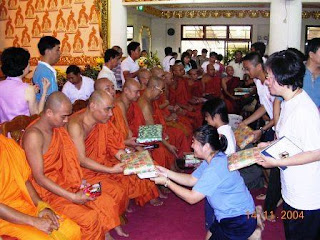The Objects of Salutation
The objects of salutation in this verse - the conquerors of the three times - are the Three Jewels of Refuge. It is important to pay homage to the Buddha not as just some noble object but in terms of the meaning of jang-chub. The Sanskrit term for jang-chub is bodhi, which conveys a sense of awakening, a state where knowledge and realization have been perfected. Therefore, when explaining the meaning of awakening or enlightenment, we can speak about both process by which this awakening takes place and the state to which awakening brings us; in other words, the means and fruition.
When we understand enlightenment as resultant state, we are primarily referring to the enlightened quality of purity - the perfected state where all negativities and limitations have been purified. There's another aspect to this purity, which is the primordially pure nature of the enlightened state. The reason why enlightenment is a perfected state where all obscuration has been purified is because natural purity is its fundamental basis.
When we understand enlightenment as a process or instrument, by which awakening is experienced, we are referring to the Buddhist enlightened quality of wisdom. This is the dharmakaya, the Buddha-body of reality, he wisdom body or wisdom embodiment of the Buddha and it is this wisdom that brings about the perfection and purification.
Thus, we can understand the significance of the explanations of the different types of nirvana in the scriptures. For example, we speak of natural nirvana, nirvana with residue, nirvana without residue and non-abiding nirvana. Natural nirvana refers to the fundamentally pure nature of reality, where all things and events are devoid of any inherent, intrinsic or independent reality. This is the fundamental ground. It is our misconception of this fundamental reality that give rise to all the delusions and their derivative thoughts and emotions.
No matter how powerful the false perceptions of reality may be at any given time, if we subject them to scrutiny we will find that they have no grounding in reason or experience. On the other hand the more we cultivate the correct understanding of emptiness as the nature of reality (and relate this understanding to actual reality), the more we will be able to affirm and develop it, because it is a correct way of perceiving the world. Flawed perceptions lack grounding, experience and reasoning, whereas grounding, experience and reasoning support the understanding of emptiness. Thus we will come to understand that this highest antidote - the wisdom of emptiness can be developed and enhance to its fullest potential. This is the understanding of natural nirvana which makes possible the attainment of the other nirvanas.
What is this natural nirvana that serves as the basis for attaining such purity and perfection? On what grounds do we know that such an ultimate nature of reality exists? We can answer these questions from everyday experience. We are all aware of the fundamental fact that there is often a gap between the way we perceive things really are. This disparity between our perception of reality and the actual state of affairs leads to all kinds of problems and confusion. However, we also know that our perception sometimes does correspond to reality accurately.
If we go deeper, we will see that there are two levels of reality. At one level, that of conventional or relative, reality worldly conventions operate and our perception and understanding of things and events is based purely upon the way things appear to us. However, when we question the ultimate status of things and events and the way that they really exist, we enter another realm or level, that of ultimate reality.
When we understand enlightenment as resultant state, we are primarily referring to the enlightened quality of purity - the perfected state where all negativities and limitations have been purified. There's another aspect to this purity, which is the primordially pure nature of the enlightened state. The reason why enlightenment is a perfected state where all obscuration has been purified is because natural purity is its fundamental basis.
When we understand enlightenment as a process or instrument, by which awakening is experienced, we are referring to the Buddhist enlightened quality of wisdom. This is the dharmakaya, the Buddha-body of reality, he wisdom body or wisdom embodiment of the Buddha and it is this wisdom that brings about the perfection and purification.
Thus, we can understand the significance of the explanations of the different types of nirvana in the scriptures. For example, we speak of natural nirvana, nirvana with residue, nirvana without residue and non-abiding nirvana. Natural nirvana refers to the fundamentally pure nature of reality, where all things and events are devoid of any inherent, intrinsic or independent reality. This is the fundamental ground. It is our misconception of this fundamental reality that give rise to all the delusions and their derivative thoughts and emotions.
No matter how powerful the false perceptions of reality may be at any given time, if we subject them to scrutiny we will find that they have no grounding in reason or experience. On the other hand the more we cultivate the correct understanding of emptiness as the nature of reality (and relate this understanding to actual reality), the more we will be able to affirm and develop it, because it is a correct way of perceiving the world. Flawed perceptions lack grounding, experience and reasoning, whereas grounding, experience and reasoning support the understanding of emptiness. Thus we will come to understand that this highest antidote - the wisdom of emptiness can be developed and enhance to its fullest potential. This is the understanding of natural nirvana which makes possible the attainment of the other nirvanas.
What is this natural nirvana that serves as the basis for attaining such purity and perfection? On what grounds do we know that such an ultimate nature of reality exists? We can answer these questions from everyday experience. We are all aware of the fundamental fact that there is often a gap between the way we perceive things really are. This disparity between our perception of reality and the actual state of affairs leads to all kinds of problems and confusion. However, we also know that our perception sometimes does correspond to reality accurately.
If we go deeper, we will see that there are two levels of reality. At one level, that of conventional or relative, reality worldly conventions operate and our perception and understanding of things and events is based purely upon the way things appear to us. However, when we question the ultimate status of things and events and the way that they really exist, we enter another realm or level, that of ultimate reality.




Comments